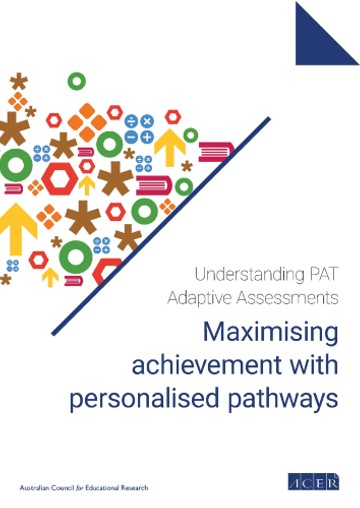
The essential guide to the world of PAT – now updated
ACER news 10 Nov 2021 5 minute readA recently updated guide to the PAT suite now includes a comprehensive booklet on our exciting new adaptive assessments.
PAT Essentials 2nd Edition contains everything you need to know about the PAT suite – assigning and administering assessments, identifying and using the most appropriate teaching resources, and professional learning that will improve learning in your classroom. This abridged extract is from the brand new booklet Understanding PAT Adaptive Assessments: Maximising achievement with personalised pathways. It's your guide to innovative adaptive assessments, PAT Maths Adaptive and PAT Reading Adaptive, launched in 2021.
 Achievement tests have traditionally been designed to assess all students’ performances on the same curriculum content, using the same test or examination, at the same time. The thinking behind this has been that, if every student attempts the same test questions under identical, or ‘standardised’, test conditions, then all students will be treated equally and can be compared fairly.
Achievement tests have traditionally been designed to assess all students’ performances on the same curriculum content, using the same test or examination, at the same time. The thinking behind this has been that, if every student attempts the same test questions under identical, or ‘standardised’, test conditions, then all students will be treated equally and can be compared fairly.
Tests of this kind usually are conducted at specific times during the schooling process – for example, at the end of a topic, school term, school year or stage of school. Year 12 examinations are an example. The purpose is to establish how much of a body of taught content students are able to demonstrate, which is then converted to a percentage or other numerical mark or letter grade.
ACER’s Progressive Achievement approach differs in many respects from this established way of thinking, and encourages you to consider the individual abilities and needs of students when administering – and analysing the results of – PAT tests. Even so, the ‘linear’ structure of conventional PAT tests, like PAT Reading 5th Edition and PAT Maths 4th Edition, share some of those traditional features and purposes.
Identifying individual starting points
Adaptive assessments have a very different starting point from traditional tests and examinations. They do not set out to assess and grade every student’s performance on the same body of taught content. Instead, they are designed to establish the points individuals have reached in their long-term progress in an area of learning. This usually means establishing what they know, understand and can do at the time of assessment. This information can then be used to identify next steps in teaching and learning and to monitor individual progress over time.
ACER’s PAT Reading Adaptive and PAT Maths Adaptive assessments have been developed specifically to achieve these aims. They do so by having students’ responses determine the test content, creating a personalised test pathway for each student. The result is a highly detailed picture of achievement, allowing you to precisely diagnose students’ needs and to target teaching where it is needed most.
More often than not, traditional reporting is not fit for the purpose of reporting a cohort’s results from an adaptive assessment. Within any classroom, the cohort of students may respond to more than 200 different questions. To meet the demands of adaptive testing and to make it easier to find, analyse and use PAT Maths and PAT Reading results data, ACER has also developed the PAT Data Explorer.
Exploring adaptive assessment data
PAT Reading Adaptive and PAT Maths Adaptive share the same assessment frameworks and achievement scales as PAT Reading 5th Edition and PAT Maths 4th Edition. This means that results between PAT Adaptive and their conventional counterparts can be directly compared.
But the nature of computer adaptive testing means that students are not tested on the same content and it is not possible to represent students’ PAT Adaptive item performance in a simple table like that found in the existing PAT Group Report.
The PAT Data Explorer has been developed in part to meet the challenge of reporting the results of adaptive assessments and to make it easier to find, analyse and use all PAT Maths and PAT Reading results data in the one location. The PAT Data Explorer also reports on two new dimensions – item proficiency for PAT Maths and strand process for PAT Reading. This additional information will provide greater diagnostic detail about your students’ achievement.
A revolution in data reporting
To assist you in making the most of your data, the PAT Data Explorer is broadly organised around three main reports that each present different aspects of your students’ results:
- Achievement report: overall student achievement at a point in time
- Item performance report: diagnostic information about student responses to items
- Progress report: student learning progress over time.
In addition to these cohort reports, an individual student report allows you to examine the achievement of a single student in depth.
Each report places at its centre the learning area’s common PAT scale and achievement bands, which reinforce the focus on where students are in their learning at a point in time, and what needs to be done to support further progress. ACER’s PAT Teaching Resources Centre, which contains hundreds of annotated questions, teaching activities and other resources, is directly accessible from these reports. ■
Find out more
Yet to purchase PAT Essentials? From November 2021, all copies automatically include the new booklet. Find out more.
Read more about PAT Adaptive.
